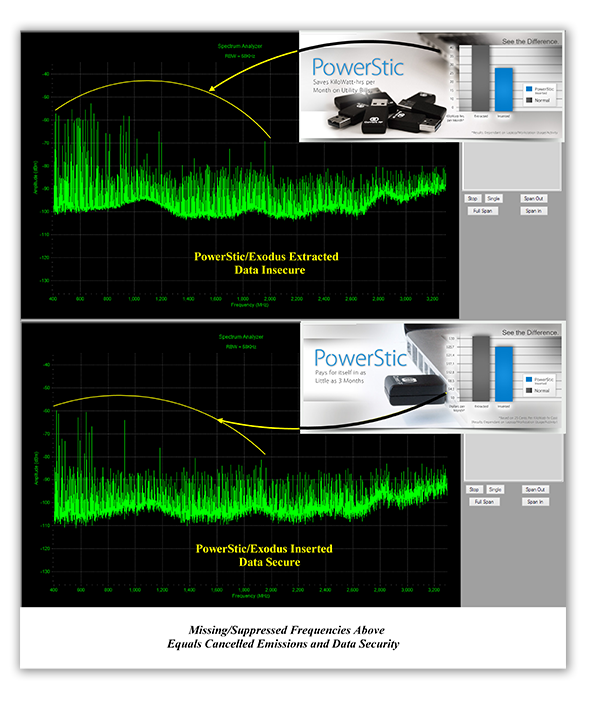Cyber Security Devices-PowerStic and Exodus
Most associate USB and it’s hardware as a digital and system data transfer protocol only. Thinking of USB in terms of Analog, RF, and as a radiating antenna has only recently been a subject of interest in USB design, a necessity with the advent of USB 3 speeds and protocols.

CurrentRF devices capture
RF effects become dominant in the data transfer speeds involved with in USB 3. CurrentRF has developed methodologies and technologies that allow server and network device USB ports, normally thought of as digital and system data transfer ports, to be used as Analog/RF pickup ports for system noise and power reduction. PowerStic and Exodus devices act as “active snubbers” for USB ports, suppressing and recycling previously radiated energy and denying Hackers access. The harvested energy allows ROI events to occur, ranging from 3 to 10 months, on average.
If one opens and ignores the data lines used for any flavor of USB, and focuses only on the resident +5V power and ground lines, one will see a rich source of RF frequencies of significant magnitude. CurrentRF has discovered that energy harvesting techniques can be employed to recover this resident, generated energy. Utilizing an ac coupled spectrum analyzer of sufficient bandwidth, one will not only see frequency spikes and noise related to USB data transfers, but “coupled in” frequencies and noise energies related to other aspects of servers and network devices.
Low Dropout Regulators
LDOs (low drop out regulators) and switch mode regulators, commonly used in data center and business devices today, do little to contain processing and clock noise energies. This noise, or dynamic power dissipation, is sufficiently high frequency in nature to couple through the system almost unimpeded.
CYBER ATTACKS
We help you protect
what matters.
As the Earth only receives a portion of the Sun’s radiated energy, so only a portion of this server and network device generated noise couples to the USB port +5V line. Thus, with this coupled in noise, a portion of this radiated noise energy can be picked up by Hackers and utilized to reconstruct Cipher keys and passwords in computer systems. See the article below for more information on this method of side channel Cyber Attack.

USB PORT
Eyes Into The System
CurrentRF devices capture and suppress USB coupled energy and process it back into the system as usable, “green” power. This energy, captured and recycled, denies Hackers access, and acts to reduce the load current on system voltage regulators, lessening the power drawn from either the wall plug or batteries. CurrentRF can recover and recycle this radiated, high frequency noise, visible at the server and network USB ports, saving power, money, and securing data in Datacenter and business networks and servers.
The USB port, then, becomes the “eyes into the system” and a RF pickup of radiated energy from processors, memory, graphics cards, HDDs and SSDs, internet activity, etc. This energy is normally ignored and treated by the industry as “throw away” and waste. If captured and recycled, even at a partial level, it denies hacker’s access and proves to be a substantial source of generated energy, and if used, can result in substantial power saving and TCO reduction in Datacenter and business systems.

Testing Our Claims
We offer on-site testing services to Power and Security analyze your systems with and without the PowerStic and Exodus devices inserted, show you the power and money one will save, retrofit a PowerStic or Exodus device into your system, and enable you to reduce your carbon footprint, making your data more secure at system endpoints.
